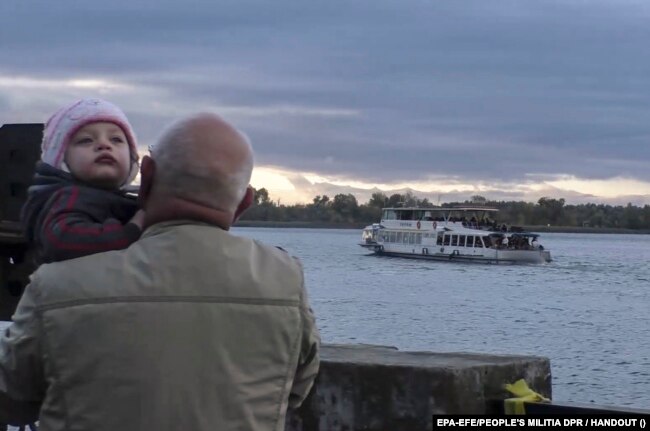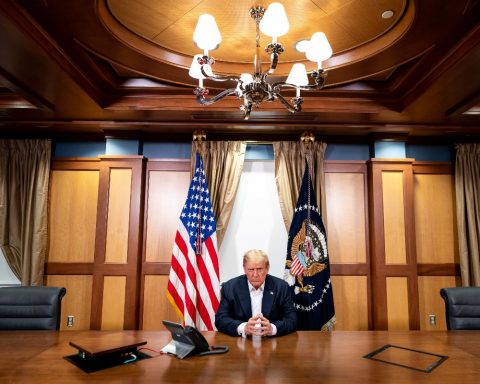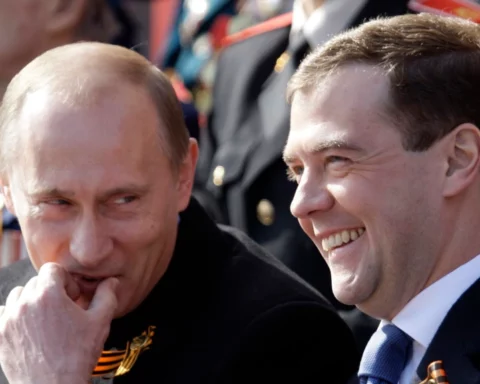As Ukrainian forces advanced toward Kherson, the only regional capital seized by Russia following its February invasion, hundreds of residents carrying basic belongings in bags could be seen boarding boats on October 19 to leave the city.
The Russia-installed authorities in Kherson have said they want to “evacuate” as many as 60,000 people from the city and the region ahead of its possible liberation by Ukrainian forces, describing it as a “humanitarian” effort and — without evidence — spreading fear of reprisals by Kyiv against its own citizens.
Ukrainian officials and Western experts say that Russia — which continues to bombard civilian objects, including energy infrastructure and apartment buildings — has ulterior motives that range from altering the region’s ethnic composition to concerns about partisan subversion.
While some of those fleeing are doing so voluntarily — from locals who threw their support behind the invasion to Russian officials and workers who were later sent to Kherson — others are being spooked and some possibly forced to leave, Ukrainian offices have said.
Kirill Stremousov, deputy head of the Russian occupation administration in Kherson, said in an October 20 post on Telegram that about 15,000 people have already been moved out of the region, a number that could not be independently verified.
Buses sent to collect people from villages outside the city of Kherson were largely empty as frightened residents tried to hide, Oleh Baturin, a Kherson-based journalist, told Current Time on October 20. He said officials were “insistent” but did not hear of people being forced to relocate.
The Kremlin’s decision to move such a large number of individuals is more about hurting Ukraine than it is about helping Russia or the people it is uprooting, analysts said.
“Russia does not appear to reap any economic benefits from resettling tens of thousands of unwilling Ukrainians in Russia, suggesting that the purpose of such removals is both to damage Ukraine’s long-term economic recovery as it retakes its territory and, more importantly, to support Russia’s ethnic cleansing campaign, which is attempting to eradicate the Ukrainian ethnicity and culture,” the U.S.-based Institute for the Study of War said in an October 19 report.
Russian forces captured the city of Kherson, which stretches along the right –western — bank of the Dnieper River, in the first weeks after the February 24 invasion, advancing northward from Crimea, the Ukrainian Black Sea peninsula seized by Russia in 2014.
However, over the past few months, Ukrainian forces have used Western weapons to pound Russian forces in the region, destroy their ammunition depots, and damage bridges critical to supplying troops in Kherson.

Russian forces in the city are now in danger of being cut off by Ukraine, and some Western military experts say they could retreat to the left — eastern — bank in the coming weeks, delivering a major blow to President Vladimir Putin’s campaign.
However, the Ukrainian military said on October 21 that Russia has sent “up to 2,000” recently mobilized soldiers to the Kherson region “to replenish losses and strengthen units on the contact line.” There was no immediate comment from Russia on the claim.
William Pomeranz, director of the Washington-based Wilson Center think tank’s Kennan Institute, said Russia’s military is already facing significant logistical and capacity problems elsewhere, noting that it is struggling to house, feed, and train what Moscow says are nearly 300,000 draftees called up under Putin’s September 21 mobilization order.
“If they had problems trying to shelter mobilized men, they will have problems finding accommodation for those moved out of Kherson,” he said.
Moscow has already relocated tens of thousands of Ukrainians from occupied areas further east to Russia, including to depopulated regions like the Far East.
Ukraine calls this process “deportation,” and many Ukrainians have gone to Russia under pressure or against their will. The removal of children has caused an outcry and accusations of genocide.
Moving people out could bog down Russian forces within Ukraine and clog roads, Pomerantz said, and Russian forces might also use the Ukrainian citizens as “human shields” to deter Ukraine from targeting troops, whether they are retreating or otherwise.
Shortly before the Russia-installed leaders announced an “evacuation,” Putin declared martial law in Kherson and three other Ukrainian regions that Moscow now baselessly claims are part of Russia. Under Russian law, the declaration formally gives the occupation authorities the power to relocate and draft citizens.
William Courtney, an analyst at the RAND Corporation, a U.S.-based think tank, said Russia may seek to conscript Ukrainian men who are relocated from Kherson into the ranks of its military. Russia’s recent setbacks are in part due to a lack of manpower.
A more likely motive for Moscow, though, is fear that local citizens could help Ukrainian forces. In other regions of Ukraine previously under Russian occupation, locals reportedly sent critical information to Ukrainian forces pinpointing the location of invading forces.
“The Russians probably don’t want Ukrainian citizens there because the Russians expect all of them to be potential spies or saboteurs on behalf of Ukraine,” Courtney said.
WATCH: During their counteroffensive in the Kharkiv region, Ukrainian forces had to cross the Oskil River to push the enemy out of key settlements. After their successful operations, a bridgehead was created on the left bank that allowed them to liberate other strategic villages in the area. Some of the Ukrainian soldiers described their tactics in detail for RFE/RL journalists.
Thomas Graham, a former specialist on Russia for the National Security Council under U.S. President George W. Bush, said symbolism cannot be discounted as a motive for the relocation effort.
In September, Russia organized so-called referendums in the Kherson, Zaporizhzhya, Donetsk, and Luhansk regions. The process had no legal legitimacy outside Russia and was denounced as a fraud by Kyiv and the West, but the announced results — overwhelming support for joining Russia — were used by Putin as grounds to claim sovereignty over all four regions.
“If the Ukrainians were to take Kherson, the fewer the number of people that are there to greet the Ukrainian forces, the easier it is going to be to explain [to Russians] that the referendum wasn’t a sham,” said Graham, a fellow at the Council on Foreign Relations, a New York-based think tank.
The Kremlin could tell Russians that “those people you see greeting the Ukrainian soldiers are sort of the leftover dregs who were traitors to begin with,” he said.






